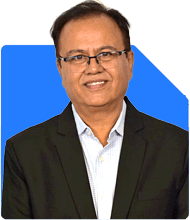Can I Retire Early at 55 with 6 Crore in Assets?
Ramalingam Kalirajan |10872 Answers |Ask -Follow
Mutual Funds, Financial Planning Expert - Answered on Apr 04, 2025
He has an MBA in finance from the University of Madras and is a certified financial planner.
He is the director and chief financial planner at Holistic Investment, a Chennai-based firm that offers financial planning and wealth management advice.... more

Dear Sir, I am a 55-year-old corporate executive retiring by 2029. My corpus is as follows - PF = 45,00,000. PPF = 3200,000. NPS = 35,00,000 (with a monthly investment of 30k). Property = 4 crores. Shares + MF = 32,00,000 (with monthly investment of around 60,000). LIC = 14,00,000 (maturing next year). FDs = 36,00,000. Apart from the above, there would be Gratuity (15 lac) and jewellery. My 2 children would be needing around 25 lac for their education spread over the next 4 years. Can I take early retirement.
Assessing Your Financial Position
Retirement is in 2029, meaning you have five more years of income and investments.
Your total corpus is well-diversified across PF, PPF, NPS, MFs, shares, FDs, and property.
You have a healthy investment habit with a Rs 60,000 monthly SIP and Rs 30,000 into NPS.
LIC maturity next year will provide Rs 14 lakh, adding to liquidity.
Gratuity of Rs 15 lakh will come at retirement, increasing your cash reserves.
Jewellery is additional wealth but is not an income-generating asset.
Financial Needs & Future Goals
1. Children’s Education – Rs 25 Lakh Needed in 4 Years
You need Rs 25 lakh over four years for education expenses.
Your FDs (Rs 36 lakh) can help cover this without disturbing your investments.
Consider a laddering approach for FDs to match the education payment timeline.
2. Regular Income Post-Retirement
Your NPS corpus (Rs 35 lakh) will generate a pension post-retirement.
EPF (Rs 45 lakh) and PPF (Rs 32 lakh) provide lump-sum retirement funds.
MFs & Shares (Rs 32 lakh) with Rs 60K SIP will continue to grow.
You have a strong base for passive income but need an income plan.
3. Healthcare & Emergency Fund
At 55 years, medical expenses will rise over time.
Ensure you have adequate health insurance for post-retirement years.
Keep at least Rs 15-20 lakh in liquid FDs or debt funds for emergencies.
Assessing Early Retirement Feasibility
1. Corpus Growth Over the Next 5 Years
Your existing investments + SIPs + NPS contributions will grow further.
With proper asset allocation, your corpus can cross Rs 5-6 crore in five years.
2. Inflation & Lifestyle Maintenance
Your current lifestyle expenses should be estimated.
Factor in inflation (6-7% per year) to assess long-term sustainability.
3. Investment Strategy for Stability
Shift some equity to balanced funds for stability closer to retirement.
Keep a mix of growth & conservative investments for steady returns.
Avoid full withdrawal of NPS—use a mix of systematic withdrawal & pension.
Final Insights
You have a strong corpus and are on track for retirement.
Continuing work for five more years will provide financial security.
Asset allocation adjustments will ensure income stability post-retirement.
Plan for rising medical costs & inflation for a stress-free retirement.
Best Regards,
K. Ramalingam, MBA, CFP,
Chief Financial Planner,
www.holisticinvestment.in
https://www.youtube.com/@HolisticInvestment
You may like to see similar questions and answers below
Ramalingam Kalirajan |10872 Answers |Ask -Follow
Mutual Funds, Financial Planning Expert - Answered on Jul 02, 2024
Ramalingam Kalirajan |10872 Answers |Ask -Follow
Mutual Funds, Financial Planning Expert - Answered on Feb 07, 2025
Sunil Lala | Answer |Ask -Follow
Financial Planner - Answered on Jul 15, 2025
Naveenn Kummar |233 Answers |Ask -Follow
Financial Planner, MF, Insurance Expert - Answered on Sep 04, 2025
Radheshyam Zanwar |6736 Answers |Ask -Follow
MHT-CET, IIT-JEE, NEET-UG Expert - Answered on Dec 06, 2025

Good luck.
Follow me if you receive this reply.
Radheshyam
Dr Nagarajan J S K |2576 Answers |Ask -Follow
NEET, Medical, Pharmacy Careers - Answered on Dec 06, 2025
Mihir Tanna |1090 Answers |Ask -Follow
Tax Expert - Answered on Dec 06, 2025
Ramalingam Kalirajan |10872 Answers |Ask -Follow
Mutual Funds, Financial Planning Expert - Answered on Dec 06, 2025
Radheshyam Zanwar |6736 Answers |Ask -Follow
MHT-CET, IIT-JEE, NEET-UG Expert - Answered on Dec 06, 2025
Radheshyam Zanwar |6736 Answers |Ask -Follow
MHT-CET, IIT-JEE, NEET-UG Expert - Answered on Dec 06, 2025
Radheshyam Zanwar |6736 Answers |Ask -Follow
MHT-CET, IIT-JEE, NEET-UG Expert - Answered on Dec 06, 2025
Dr Dipankar Dutta |1837 Answers |Ask -Follow
Tech Careers and Skill Development Expert - Answered on Dec 05, 2025
Dr Shyam Jamalabad |108 Answers |Ask -Follow
Dentist - Answered on Dec 05, 2025
Dr Shyam Jamalabad |108 Answers |Ask -Follow
Dentist - Answered on Dec 05, 2025











.jpg)














